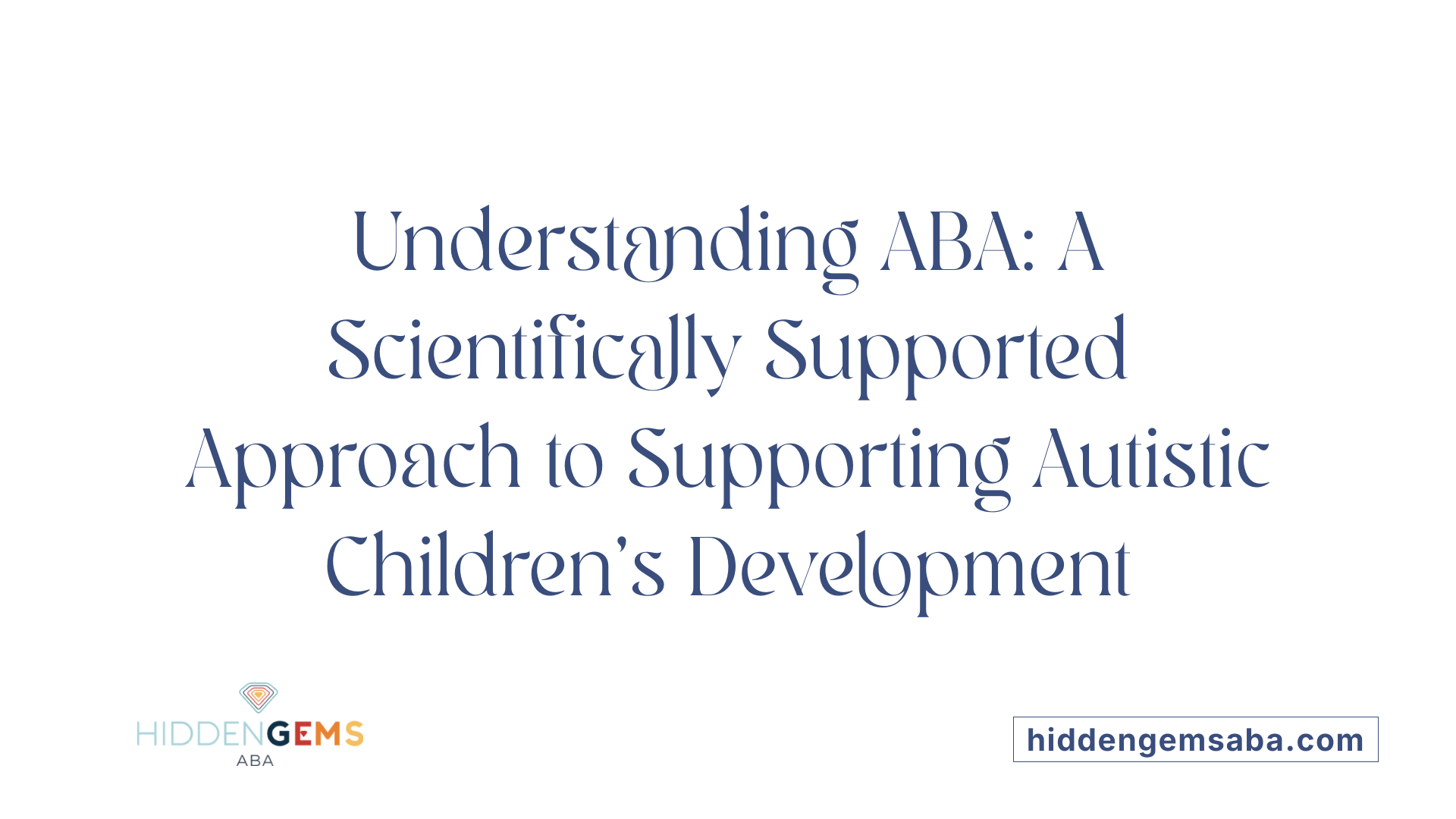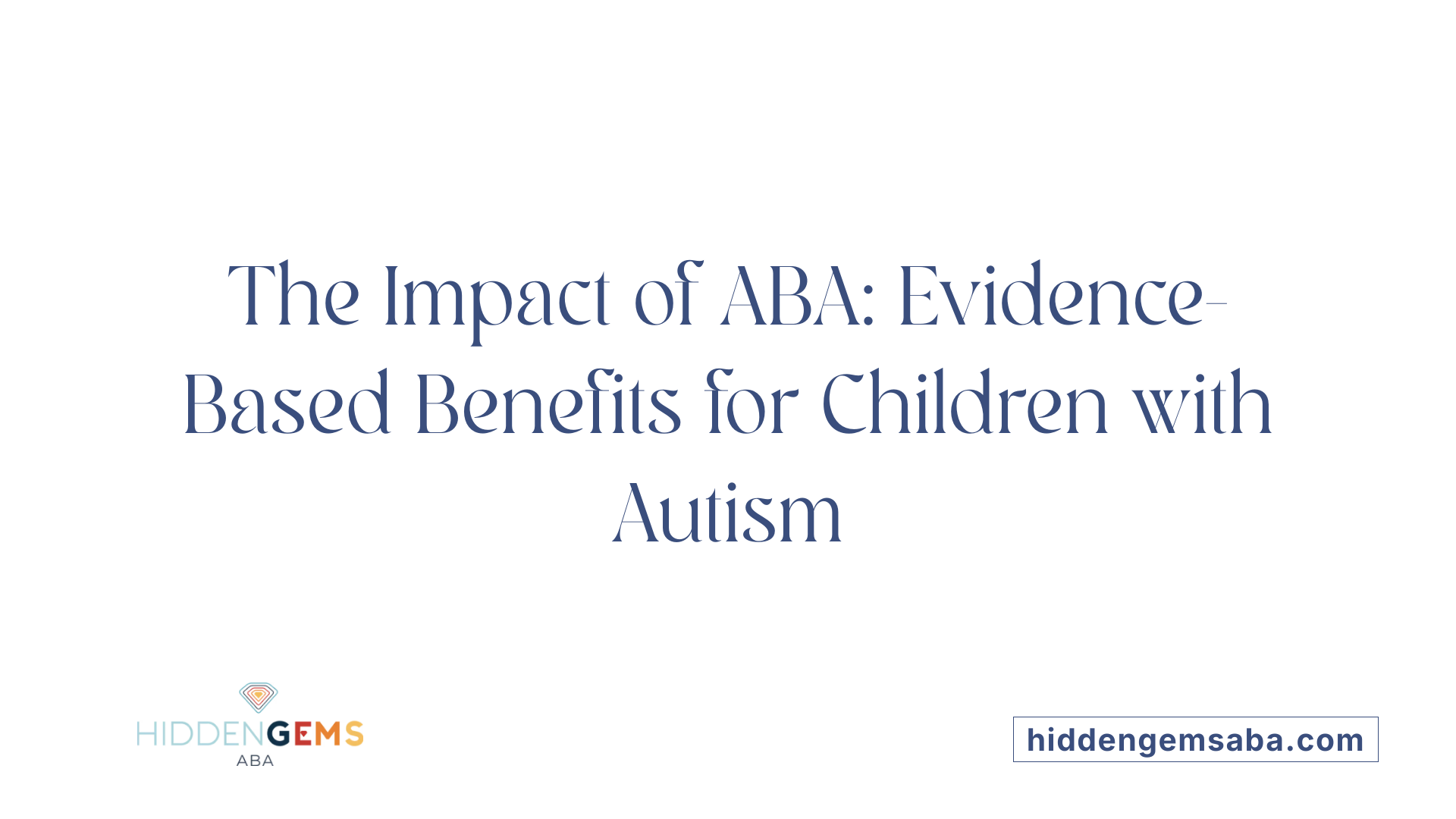Understanding ABA Therapy and Its Impact
Applied Behavior Analysis (ABA) is a scientifically supported, evidence-based therapy that has revolutionized behavioral development strategies for children with autism spectrum disorder (ASD). Rooted in the science of learning and behavior, ABA aims to promote positive behaviors, reduce harmful or maladaptive ones, and foster independence and social skills. This article explores the fundamentals of ABA, its methods and techniques, the evidence backing its effectiveness, and contemporary perspectives on its application.
What is ABA Therapy and How Does It Support Behavioral Development in Children with Autism?

What is ABA therapy and how does it support behavioral development in children with autism?
Applied Behavior Analysis (ABA) is a scientifically supported approach to therapy that aims to improve social, communication, and behavioral skills in children diagnosed with autism spectrum disorder (ASD). It is based on the principles of behaviorism, which focus on understanding and changing behavior through environmental influences.
ABA therapy involves a detailed assessment of the child’s needs and the development of personalized treatment plans. These plans are designed to encourage positive behaviors using techniques like positive reinforcement—rewarding desirable actions to increase their frequency—and prompting, which helps guide the child through new skills.
The core of ABA is analyzing the triggers and consequences of behaviors. Therapists observe what happens before and after a behavior to understand its function. This approach allows the creation of targeted strategies to promote meaningful, functional skills that are important for everyday life.
Several specific methods are used within ABA, including Discrete Trial Training (DTT) and Natural Environment Teaching (NET). DTT offers structured, step-by-step instruction, providing clear prompts and immediate reinforcement, which is especially effective for teaching new skills. In contrast, NET involves teaching in everyday settings and natural routines, making skills more relevant and easier to generalize.
By systematically applying these techniques, ABA helps reduce challenging behaviors such as aggression or self-injury. Simultaneously, it promotes independence by teaching daily living skills, communication, social interactions, and adaptive behaviors.
Family involvement is a vital component of successful ABA therapy. Caregivers are trained to continue reinforcement and behavioral strategies at home, ensuring consistency and generalization of skills across different settings.
Research consistently supports ABA’s effectiveness, showing significant improvements across numerous skills in children with autism. The therapy’s tailored nature allows it to adapt to each child's unique needs, making it effective from early childhood through adulthood.
Overall, ABA provides a structured, evidence-based framework that helps children with ASD develop crucial skills, reduce problematic behaviors, and participate more fully in society. This comprehensive approach not only benefits children in the short term but also supports their long-term growth and independence.
Core Techniques in ABA Therapy and How They Are Implemented

What are common techniques used in ABA therapy?
Applied Behavior Analysis (ABA) employs several techniques that focus on improving behaviors and learning new skills. Among these, positive reinforcement stands out as a fundamental method. This involves giving a rewarding stimulus immediately after a desired behavior occurs, increasing the likelihood that the behavior will happen again. Reinforcements can include praise, tokens, or access to preferred activities.
Prompting is another key approach used in ABA. It involves providing cues or assistance to guide the individual toward correct responses. Prompts can be physical, verbal, or visual, and they help learners understand what is expected of them.
As individuals gain skills, prompts are gradually faded out to promote independence. Fading reduces the level of assistance over time, making sure the learner can perform the task without prompting.
In addition to prompting and reinforcement, visual and video modeling are employed. These methods involve demonstrating desired behaviors visually, allowing learners to observe and imitate. They are especially beneficial for children with autism who are visual learners.
To break down complex skills into manageable parts, ABA practitioners use task analysis, which involves dividing a task into small, teachable steps. Behavior chaining then links these steps into a complete sequence, enabling learners to perform multi-step tasks.
Data collection and analysis are integral throughout ABA therapy. Precise records help clinicians monitor progress, evaluate the effectiveness of interventions, and make necessary adjustments.
How do these methods promote behavior change?
The combination of positive reinforcement, prompting, fading, modeling, and task analysis creates a structured yet flexible framework. This framework helps individuals acquire new skills, reduce harmful behaviors, and become more independent. Each technique is tailored to the individual's needs, ensuring that interventions are both effective and ethically sound.
How are these techniques applied in practice?
In practice, a Board Certified Behavior Analyst (BCBA) designs personalized programs that incorporate these techniques. For example, during a session, a child might be rewarded with a favorite toy for completing a task after clear visual prompts. As the child becomes more proficient, prompts are gradually removed to foster autonomous performance.
This systematic approach emphasizes not just skill acquisition but also social and communication improvements, aligning with the goals of ABA therapy to support meaningful participation in everyday life.
Evaluating the Benefits and Proven Effectiveness of ABA

What are the benefits and effectiveness of ABA therapy for children with autism?
Applied Behavior Analysis (ABA) is widely recognized as an evidence-based treatment for children with autism spectrum disorder (ASD). Over the decades, extensive research has consistently demonstrated that ABA can bring significant improvements across various developmental areas.
One of the main benefits of ABA therapy is its ability to enhance communication skills. Children often learn to express their needs and engage in social interactions more effectively after participating in ABA programs. This is achieved through techniques like positive reinforcement, where successful responses are rewarded, encouraging repetition and mastery of desired behaviors.
In addition to communication, ABA helps improve social skills by promoting appropriate behaviors during interactions with peers, family members, and teachers. Children are also supported in developing daily living skills such as dressing, eating, and grooming, which are essential for increasing independence.
Research findings reveal that early and intensive ABA interventions produce substantial developmental gains. For children under the age of four who receive more than 20 hours of therapy per week, studies show a notable reduction in autism symptoms and a greater likelihood of mainstream inclusion later in life.
Overall, multiple studies report positive changes in 63% to 88% of measured outcomes, including improvements in cognition, language development, and adaptive behaviors. These outcomes are typically assessed through structured observations and standardized tests conducted by trained professionals.
Parental involvement and regular assessments by certified professionals, especially Board-Certified Behavior Analysts (BCBAs), significantly enhance the effectiveness of ABA. Tailoring programs to meet individual needs ensures that each child receives the appropriate level of support.
While the body of research overwhelmingly supports ABA’s benefits, the quality and scale vary across studies. Larger, prospective research comparing ABA with other interventions and examining quality of life (QoL) outcomes are needed to strengthen the evidence base.
In summary, ABA not only helps children with autism develop essential skills but also improves their overall independence and social integration. Its structured, yet adaptable approach, grounded in scientific principles, makes it a cornerstone intervention endorsed by major health and education authorities worldwide.
Applying ABA to Autism and Developmental Disabilities Past and Present

How does ABA therapy apply to autism and other developmental disabilities?
Applied Behavior Analysis (ABA) is a scientific approach that uses principles of learning and behavior to support individuals with autism and other developmental challenges. It focuses on increasing helpful behaviors and decreasing harmful or hindering ones.
ABA employs a variety of techniques such as positive reinforcement, prompting, and analyzing the triggers and consequences of behavior. For example, a therapist might reward a child for attempting to communicate, helping to strengthen the child's ability to express their needs.
Therapists conduct assessments to understand each individual’s unique needs, creating customized programs tailored to their skills and goals. These programs are carefully designed and regularly adjusted by trained professionals, especially board-certified behavior analysts (BCBAs), to ensure they remain appropriate and effective.
The approach is versatile and can be applied across many settings, including the home, school, and community environments. The overarching goal is to help individuals become more independent and capable of participating successfully in daily life.
Research demonstrates that ABA is an evidence-based treatment recognized globally. It has shown positive effects on various skills such as language development, social interaction, and adaptive behaviors. Additionally, it can reduce problematic behaviors that interfere with learning and safety.
While ABA is rooted in behaviorist principles, contemporary practice emphasizes building on individual strengths, incorporating play, and respecting neurodiversity. This means therapy aims to support children in developing meaningful skills without trying to change their core neurobiological makeup.
Many studies support the effectiveness of ABA, with reports indicating improvements in cognitive, communication, social, and emotional areas. It is endorsed by major health organizations such as the CDC and NIH, standing as a leading approach in autism intervention.
Despite its successes, ABA continues to evolve. Current practices favor more naturalistic and play-based methods, moving away from rigid, repetitive drills. The importance of personalized intervention cannot be overstated; therapy plans are shaped to meet each child's specific needs and interests.
Application across lifespan
ABA’s benefits extend beyond childhood. For adolescents and adults with autism, ABA can teach essential life skills, promote social adaptation, and decrease dangerous or disruptive behaviors.
For very young children, intensive early intervention — often more than 20 hours per week — can lead to significant developmental gains and a reduction in the need for special support later in life.
In older individuals, ABA techniques are tailored to help develop skills that support independence, such as self-care, communication, and community participation. It can also address challenging behaviors that threaten health and safety, opening more opportunities for employment, education, and social connections.
Settings for ABA
The flexibility of ABA allows it to be delivered in various environments:
| Setting | Purpose | Techniques Used | Benefits |
|---|---|---|---|
| Home | Family-centered training | Play-based, reinforcement | Builds routines, generalizes skills |
| School | Educational support | Discrete Trial Training (DTT), PRT | Enhances learning, social skills |
| Community | Real-world application | Naturalistic interventions | Promotes independence, community integration |
Individualized treatment plans
Personalization is at the heart of ABA therapy. After comprehensive assessment, a BCBA crafts a treatment plan focusing on specific goals such as language, social skills, or reducing problematic behaviors.
Plans are flexible and regularly monitored, with progress data guiding adjustments to maximize effectiveness.
Involvement of parents, teachers, and caregivers is crucial to ensure consistency and support across environments.
This personalized, comprehensive approach makes ABA a powerful tool in helping individuals with autism and disabilities lead more independent, successful lives.
| Aspect | Details | Additional Notes |
|---|---|---|
| Duration | Varies based on needs, often 10-20 hours/week | Intensive early intervention common |
| Techniques | Reinforcement, prompting, DTT, PRT, ESDM | Tailored by individual needs |
| Settings | Home, school, community | Ensures generalization |
| Goals | Communication, social, independence | Focus on meaningful life skills |
Overall, ABA remains a cornerstone of autism and developmental disability treatment, continuously adapting to new research and societal values to serve individuals better.
Historical Foundations and Scientific Evidence Supporting ABA
What is the historical background and research evidence supporting ABA therapy?
Applied Behavior Analysis (ABA) traces its roots back to the early developments in behaviorism in the 20th century. Pioneers like Ivan Pavlov, John B. Watson, and B.F. Skinner laid the groundwork by focusing on observable behaviors and the principles of reinforcement and response. These foundational ideas emphasized that behavior could be learned and modified through systematic methods.
In the 1960s, the field took a significant step forward when Dr. Ivar Lovaas applied ABA techniques specifically to children with autism. His groundbreaking work involved intensive, structured therapy sessions aimed at teaching essential skills. Lovaas’s early studies demonstrated remarkable progress in children, often resulting in reduced problem behaviors and enhanced cognitive and communication skills. These results showed that targeted behavioral interventions could transform developmental trajectories for autistic children.
As the understanding of ABA deepened, practices began to shift from rigid, drill-based methods towards more flexible, naturalistic approaches. Modern ABA incorporates family involvement, environment-based strategies, and cultural adaptations to make interventions more effective and engaging.
Research over the decades has provided substantial evidence for ABA’s effectiveness. More than 20 controlled studies and numerous clinical reports highlight its capacity to improve various skills, including language, social interaction, self-care, and adaptive behaviors. These studies show positive outcomes in 63% to 88% of cases, confirming that ABA can produce meaningful and lasting developmental gains.
Leading health organizations worldwide, such as the Centers for Disease Control and Prevention (CDC), the American Psychological Association (APA), and the National Institute of Mental Health (NIMH), endorse ABA as an evidence-based treatment for autism and other developmental disorders. The continuous evolution of techniques and growing research support the ongoing role of ABA as a scientific and practical approach to behavioral intervention.
In summary, ABA’s origins are rooted in early behaviorist theories that revolutionized how we understand behavior. Its application to autism has been validated by rigorous scientific studies, making it a cornerstone of evidence-based practice. The ongoing development of ABA techniques ensures their relevance and effectiveness in improving quality of life for individuals with autism.
Contemporary Perspectives, Criticisms, and Ethical Considerations
How have modern practices in ABA shifted from earlier approaches?
Over the decades, Applied Behavior Analysis (ABA) has evolved significantly. Early ABA techniques, developed in the 1960s by Dr. O. Ivaar Lovaas, often incorporated reinforcement strategies alongside aversive methods like electric shocks and punishment. These approaches aimed to reduce undesirable behaviors but raised ethical concerns.
Today, contemporary ABA emphasizes positive reinforcement, naturalistic teaching, and individualized programs that respect neurodiversity. Instead of rigid, structured interventions solely focused on conformity, current practices incorporate play-based activities, social participation, and strengths-focused strategies. This shift reflects a broader understanding of autism as a natural neurodiverse variation, aiming to help children develop meaningful skills without trying to erase their inherent traits.
ABA professionals now prioritize building collaborative, respectful relationships with clients and involve families and communities in treatment planning. This evolution underscores a move towards ethically sound, person-centered care.
What are the criticisms and controversies surrounding ABA therapy, and what are current professional perspectives?
Despite its widespread acceptance, ABA faces ongoing criticisms, particularly from autistic advocates and some professionals. Historically, ABA included methods that used punishment and enforced behavior compliance, which some argue caused emotional harm, trauma, and a loss of identity.
Critics often highlight concerns that ABA can encourage masking—forcing autistic individuals to hide their natural traits to conform to societal norms—leading to mental health challenges and social isolation. They also point out the risk of emotional distress and the potential to suppress authentic behaviors instead of supporting genuine self-expression.
In response, many practitioners and organizations now acknowledge these concerns. Modern ABA advocates promote approaches rooted in positive reinforcement, respect for neurodiversity, and the promotion of engaging, meaningful activities. They stress the importance of community involvement, transparency, and personalized interventions that prioritize the individual’s dignity and well-being.
The professional consensus is shifting toward ethical practice standards that prevent harm, promote autonomy, and recognize the importance of cultural and individual differences. Ongoing debates focus on ensuring that ABA therapy aligns with the values of respect, acceptance, and empowerment.
How is neurodiversity integrated into current ABA practices?
Neurodiversity emphasizes that neurological differences, including autism, are natural human variations deserving of acceptance and respect. In modern ABA, this perspective encourages practitioners to view autistic traits not merely as deficits but as part of an individual's identity.
Practitioners incorporate strategies that support autonomy, self-advocacy, and participation in community life. They aim to teach skills that enhance independence and quality of life while honoring the individual's unique sensitivities and preferences.
By focusing on strengths rather than damage, and by avoiding efforts to make individuals conform to neurotypical standards, current ABA aligns with values of inclusion and respect. This approach seeks to empower autistic individuals to lead fulfilling lives, respecting their neurodiverse identities.
What are the ethical practices and community involvement essential in current ABA therapy?
Ethical ABA involves transparent communication, informed consent, and collaboration with clients and families. Practitioners follow guidelines that prevent harmful practices, avoid unnecessary punishment, and prioritize the individual's dignity.
Community involvement is crucial. This includes involving autistic individuals and advocacy groups in developing and reviewing intervention plans, ensuring that therapy respects cultural, social, and personal values.
Ongoing monitoring, critical self-assessment by practitioners, and adaptation based on feedback help maintain high ethical standards. Education and advocacy also play roles in promoting understanding of autism and neurodiversity.
Ultimately, ethical ABA practices foster trust, respect, and empowerment, aligning interventions with the well-being and preferences of the individuals served.
| Aspect | Description | Related Ethical Considerations |
|---|---|---|
| Practice Shifts | Moving from punishment to positive reinforcement | Respect, non-harm, autonomy |
| Criticisms | Concerns about masking, emotional harm | Cultural sensitivity, transparency |
| Neurodiversity | Viewing autism as a natural variation | Acceptance, empowerment |
| Community Role | Including autistic voices in planning | Collaboration, shared decision-making |
| Monitoring | Regular review and participant feedback | Ethical accountability, responsiveness |
This ongoing dialogue ensures ABA remains an ethical, effective, and socially respectful therapy option for autistic individuals, emphasizing growth, dignity, and community connection.
Looking Ahead to Inclusive and Evidence-Based Autism Support
As ABA therapy continues to evolve with a focus on ethical, individualized, and neurodiversity-respecting practices, it remains a cornerstone in autism intervention supported by rigorous scientific research. Understanding its methods, benefits, and limitations helps caregivers and professionals make informed decisions that prioritize dignity, respect, and the unique strengths of each individual. Future directions aim to integrate community-driven approaches, enhance the quality of life for autistic people, and uphold the core values of respect and empowerment.
References
- Applied Behavior Analysis (ABA) | Autism Speaks
- Applied Behavior Analysis (ABA) - Cleveland Clinic
- Applied Behavior Analysis in Children and Youth with Autism ...
- Behavioral Treatment of Autism and Other Developmental ... - BACB
- The Controversy Around ABA - Child Mind Institute
- Behavioral Therapy for Autism Spectrum Disorder in Children
- [PDF] Behavioral Treatment of Autism and Other Developmental Disabilities
- Applied Behaviour Analysis (ABA) and autistic children
- Behavioral Management Therapy for Autism | NICHD
- Is ABA therapy harmful? The controversy explained






